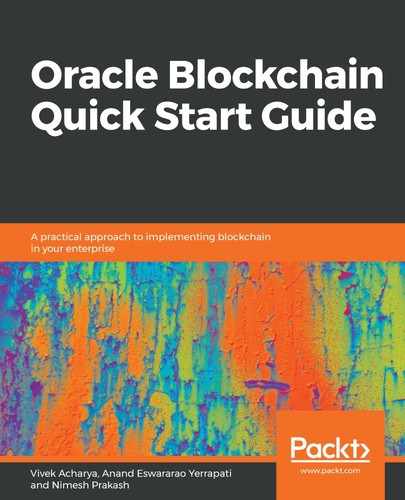With blockchain, the KYC/on-boarding process will be as follows:
- The applicant approaches the bank with their government ID, address, and tax proofs.
- The bank will scan the document, along with the biometrics of the applicant, and push it to blockchain (assuming that banks start using biometrics for on-boarding). Alternatively, the customer can upload his/her KYC documents to blockchain directly (as shown in the preceding diagram).
- The blockchain network will use certain attributes of the government IDs, such as SSN number and date of birth, and, if biometrics is enabled, will use biometrics to generate a unique digital identity of the applicant. If the applicant already exists, verified information will be returned to the bank.
- When a new applicant is added to the blockchain, a transaction is performed, which the participating banks and financial institutions verify. Hence, digital identity is highly assured and added based on consensus, which also means it's reliable. Similarly, any change that's made to an already existing customer's information can be appended to the blockchain upon consensus. All updates and new additions are accessible to participating banks and financial institutions in real time.
- The verified applicant is added as a customer.
- Transactions that are performed by that customer will always include their digital signature.
This ensures the creation of the digital identity of the customer and that each transaction has a verified digital signature. However, let's discuss who can access the data on the blockchain. Since data is available on a shared distributed ledger, it can be accessed by third parties for verification, but only after permissions are granted. This checks any unauthorized access to data and empowers individual users and institutional users.
When an applicant provides information to a bank, along with its biometrics, their digital identity is created by the blockchain system. However, no-one can access it until the user grants consent. The user will own the data, and others can access it only after the user provides consent. Users can grant consent by logging in to the KYC portal (the unified KYC portal as a dApp of the blockchain network) and establishing a private key to the data. Now, banks and other third parties can access the data for verification purposes, and the data is still owned by the user. In addition, each verification request and each access to user data will leave a trace, which will empower the end user and inform them about who's using their information and for what.
The KYC process can be built as a smart contract, which can then be used across industries and further induces standardization. Blockchain offers strict checks against fraud as data on the blockchain is immutable. Banks and financial institutions don't need to perform verification individually. Since data is on a shared distributed ledger, various parties can access it, although it is still owned by the end user. As transactions are signed, any fraudulent activity can be spotted and communicated across the blockchain network. Since data on the ledger is trusted, reliable, and immutable, secondary verification isn't required. Scams and fraudulent transactions can be spotted in real time, which saves time and the aftermath of undetected frauds and scams.
The KYC solution we discussed previously is a distributed digital identity solution of the customers. In addition, bringing banks and financial institutions to the blockchain eliminates redundancy. Signing transactions with the digital identity helps check against frauds and identify illegal and fraudulent transactions. However, KYC and its underlying digital identity solution on blockchain have various use cases as well. It can find solutions to use cases that need a unique digital identity; for example, membership cards, legal systems, and credit rating agencies. Along with this, all of those use cases where transactions are involved are a prime candidate for a blockchain-based KYC solution. Examples include wagers, digital rights, micro financing, P2P lending, remittance, global payments, equity, debt, crowdfunding, derivatives, voting, ownership, title records, intellectual property, and healthcare.
